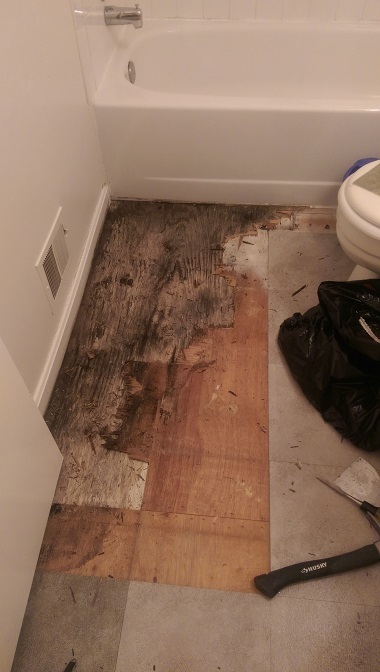Just How to Avoid Bathroom Water Damage
Just How to Avoid Bathroom Water Damage
Blog Article
Almost everyone maintains their private perception involving How to Prevent Bathroom Water Damage.

The washroom is extremely at risk for damp buildup as well as possible water damage because of the constant use of water in it. This post supplies easy examination techniques to assist detecting water damage dangers.
The constant use of water in the shower room makes it exceptionally vulnerable for damp buildup and prospective water damages. By inspecting it frequently, you can minimize water related damages.
The complying with collection of inspections is simple to do and ought to be done when in every 3 months in order to maintain your shower room healthy and also to prevent potential water damages brought on by the bath tub, the shower, pipe joints and plumbing, sinks, cupboards, and also the commode
Do not neglect performing these evaluations as well as be complete while executing them. Remember that these straightforward inspections can save you a lot of money by supplying very early signs for water damages
Sinks and also Cabinets
Sinks and also closets are revealed to moisture as well as moisture daily and are typically ignored. Evaluate regularly under the sink and on the counter top over it. Fix any type of drip in the trap as it may recommend drainpipe issues. Browse the sink, slow-moving draining pipes may show an obstructed drain. Replace sink seals if they are fractured or loose.
Bathtub as well as Shower
The shower and also bathtub call for special interest as well as upkeep. Examine the tiles as well as change if fractured. Make sure that there is no missing grout between the ceramic tiles. Evaluate and also change fractured caulking at joints where the wall surfaces fulfill the flooring or the bath tub. Obstructed drains pipes and also pipelines troubles will certainly protect against the tub from drying out and may indicate serious troubles under the bath tub. Seek advice from a specialist quickly to stop architectural damage. Take note of discolorations or soft areas around the bathtub walls as they might show an inner leakage.
Plumbing
Signs for water damage are difficult to spot because most pipelines are mounted inside the wall surfaces.
Pay special attention to flooring and also wall surfaces wetness as well as stains as they might show an unseen plumbing issue. Check dampness degrees in adjacent rooms as well.
The Commode
The bathroom is a susceptible water junction. Examine the water lines as well as search for leaks around the commode seat, in the pipe, as well as under the water tank. If you identify any type of indications of dampness on the floor around the bathroom, check for leakages in the toilet rim and also tank seals.
Realize that hanging bathroom bowl antiperspirants increases the opportunities for clogs.
Water Damage Signs In The Bathroom To Avoid Cleanup
Musty smell
This is one of the easiest signs to catch because musty smells are so odorous. The damp, earthy, moldy smell should be a big red flag. The smell will develop when moisture gets trapped in surfaces, and begins to facilitate mold growth. Leaking pipes under cabinets, inside walls, and behind shower fixtures will cause moisture to stay trapped and not dry, which will lead to mold growth and spread. As soon as you notice any musty smells in your bathroom, have it checked for hidden water damage and cleanup signs.
Visible mold
If the smell isn’t there to give it away, sometimes you will actually see mold growth. Finding mold in your bathroom is a serious problem, because mold is very harmful to your health. By the time mold growth is visible, it also means that water damage has already occurred and been present for some time. The only way the mold problem can be resolved is to find the source of the moisture and get it stopped. To safely and adequately remove mold, you need to have professionals handle the remediation. Do not waste any time in getting mold problems addressed, fixed, and sanitized so that you can protect you and your family from the many respiratory symptoms caused by mold exposure.
Damaged floors
Bathroom floors should be able to withstand some exposure to water while still remaining in good condition. However, when excess exposure or water leaks occur, they will begin to damage even the most water-resistant flooring. If you notice any cracking, bubbling, staining, or warping on your bathroom floors, there is probably a water leak somewhere causing the distortion. If you notice areas of the floor have become softer, or even have a spongy feeling, there is probably damage to the subfloor. Subflooring is typically made up of plywood. When plywood is exposed to water or moisture, it will absorb it. Once it has become saturated, the weight of the excess water will cause the wood to swell and soften. Check the floors in your bathroom frequently to catch any of these sings before they lead to damaged subflooring.
Changes on walls
When water leaks behind walls, it will cause changes in the drywall. Peeling plaster, blistering paint, and soggy wallpaper are all good indicators that excess water is building up behind the wall. Water leaking behind drywall will cause it to swell and be soft to the tough. If you start to notice gaps along the trim of your walls, or where tile meets the wall, it could also be a strong indicator that there is a leak behind the wall. Any changes, distortion, or damage on the walls should be evaluated as soon as you notice it to prevent further water damage and cleanup.

I found that piece of writing about Preventing Water Damage in the Bathroom while doing a lookup on the web. Loved our write-up? Please share it. Let someone else locate it. Thanks for going through it.
Book Maintenance Report this page